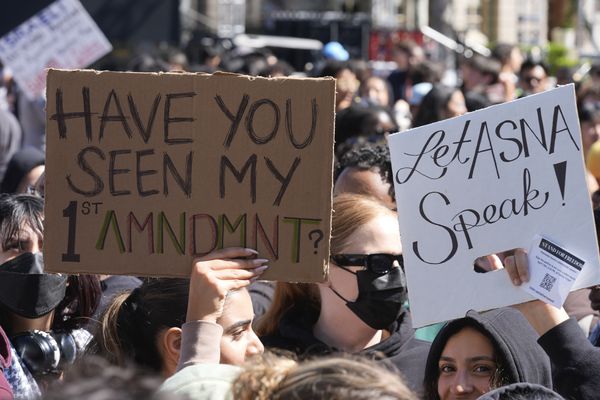
NEW YORK — Maybe the image is not racy, like the one of Marilyn Monroe with her dress flying up in the movie “The Seven Year Itch,” but on Monday night, it became the priciest.
In under 4 minutes of bidding, Andy Warhol’s 1964 silk screen of the actress’s face, “Shot Sage Blue Marilyn,” sold for about $195 million to an unknown buyer at Christie’s, making it the highest price achieved for any American work of art at auction.
“We did sell the most expensive painting of the 20th century,” said Christie’s specialist Alex Rotter. “This is a big achievement.”
The 40-inch-square painting, a trophy given its vibrant colors and glamorous subject matter, eclipsed the previous high price of $110.5 million for a Jean-Michel Basquiat skull painting at Sotheby’s in 2017 as well as Warhol’s auction high for a car crash painting that sold for $105.4 million in 2013.
Monday's sale kicked off a spring auction season in a city that has only begun to return to normal after two years of the coronavirus pandemic. Christie’s salesroom at Rockefeller Center was filled with the familiar faces of dealers and art advisers who clearly welcomed the opportunity to bid on blue-chip artworks in person again.
“There is a lot of appetite, there is a lot of money and there is a lot of quality,” said Austrian gallerist Thaddaeus Ropac, who was at the sale. “With all these things, it should work.”
Philip Hoffman, founder of the Fine Art Group, a New York advisory company, said the upcoming two weeks of auctions could raise as much as $2 billion. “There’s been a huge amount held back for two years, and there’s a huge amount of pent-up demand from new clients,” he said. “Everyone was waiting for the right moment, and the right moment has come.”
The Christie’s auction was unusual in that none of the works were accompanied by a guarantee — a minimum price at which a third party or the auction house has committed to purchase the work. That is because the works were consigned by the estate of Swiss dealers (and siblings) Thomas and Doris Ammann, with all of the proceeds going toward their foundation, which supports health care and educational programs for children. The estate wanted to maximize the charitable proceeds.
Before the sale, Christie's CEO Guillaume Cerutti reveled in the absence of guarantees, given the risky quality of flying without a net. “Like the old times,” he said. “Real sport.”
The buyer of the “Marilyn” will have a say in choosing to which charity 20% of the proceeds from that painting are allocated. The purchase is not considered a charitable donation, so it does not come with a tax deduction,

In 1977, the Ammanns founded a Zurich gallery that specialized in impressionist, modern, postwar and contemporary artists. After Thomas Ammann’s death in 1993, his sister continued to lead the gallery. She died last year.
“The top of the market is still strong and there is a lot of demand for quality,” art dealer Bill Acquavella said. “Look what real estate is selling for. There are other assets that are bringing prices that you haven’t seen before.”
The 36 works in the sale, which brought a total of $318 million (two lots did not sell), bore out the truism that top-quality works sell for top prices, however tumultuous the state of the world — be it a war overseas, a pandemic or a terrorist attack.
The auction, in Christie’s newly designed sales room with specialists positioned on the sides and reporters on stools in the back, was strong out of the gate. The energy crackled in the room as veteran auctioneer Jussi Pylkkanen toggled between bidders on the phone and in the seats. “I have 15 bidders for this one!” he said as Ann Craven’s canvas of three birds, “I Wasn’t Sorry, 2003,” ultimately sold for $680,400 over a high estimate of $40,000.
The first lot, a work by American conceptual artist Mike Bidlo, “Not Picasso (Bather with Beachball),” estimated at $60,000 to $80,000, went for $1.3 million with fees.
Collector Peter Brant, seated in the third row, bought the third lot, Francesco Clemente’s “Fourteen Stations, No. XI,” for $1.9 million, over an estimate of $80,000 to $120,000. Then dealer Larry Gagosian purchased Cy Twombly’s blue, green and purple painting on a wooden panel for about $17 million, over the high estimate of $15 million.
By comparison, the Marilyn silk screen — which Rotter recently called “the most significant 20th-century painting to come to auction in a generation” — felt like something of an anticlimax. Yes, it set a record, but speculation in advance of the auction had the painting soaring to as much as $400 million. Instead, the auctioneer seemed to wring the bids, with the painting ultimately going to Gagosian; it was unclear on whose behalf he was bidding.
“Expectation was very, very, very high,” art adviser Abigail Asher said. “It was an incredibly healthy price, but at the same time, I believe the buyer got a deal. It’s one of the icons of 20th-century art.”
Some wondered whether the stock market’s poor performance Monday might have muted the “Marilyn” bidding. The Warhol painting, one of five in a series, is based on a promotional photo from the actress’s film “Niagara,” part of a series of “Shot Marilyn” portraits. In 1964, a woman walked into Warhol’s Factory studio with a pistol and shot at a stack of four Marilyn paintings. (The canvas up for auction at Christie’s was not pierced by the bullet.)
The Ammanns bought the work from media mogul S.I. Newhouse Jr. in 1998; that year, Newhouse purchased Warhol’s “Orange Marilyn” (1964) at Sotheby’s for $17.3 million. After Newhouse’s death, in 2017, billionaire hedge-fund manager Ken Griffin bought that work privately for about $200 million.

The big question hanging over this auction season is whether — with a surfeit of blue-chip art coming up for sale and a limited pool of very rich buyers — the current market can absorb so much big-ticket material.
“Art market players expected the Warhol to provide another shot in the arm to the already strong contemporary art market,” said Thomas Danziger, an art market lawyer. “The big question is whether bidders will pull the trigger on other high-priced works this week and next.”
The sales continue this week with Christie’s 21st Century evening sale on Tuesday as well as its collection of Anne H. Bass and 20th Century evening sale on Wednesday. On Thursday, Christie’s will offer a 1909 Picasso bronze cast, “Head of a Woman (Fernande),” that was recently deaccessioned by the Metropolitan Museum of Art. It is estimated at $30 million and has a guarantee.
On May 16, Sotheby’s will offer the remainder of the Macklowe collection, the fruits of the bitter divorce between real estate developer Harry Macklowe and his former wife, Linda, the first cache of which brought $676.1 million in the fall.
On May 18, Phillips will hold its 20th Century & Contemporary Art evening sale, featuring a bright orange 1982 untitled Basquiat with an estimate of $70 million; the seller, Japanese entrepreneur Yusaku Maezawa, bought it just six years ago at Christie’s for $57.3 million.
“Expectations are really high,” said Rebecca Fine, managing director of Athena Art Finance. “These are museum-quality works they’re selling.”
The relationship between Warhol and Basquiat continues to fascinate, given their history as competitors as well as collaborators and close friends. In 1985, dealer Tony Shafrazi designed a poster promoting his show of paintings made jointly by the two artists that featured them in boxing gloves as if preparing to spar with each other.
“I just love that, even in death, they’re still in this boxing match with one another,” said Jessica Beck, curator of art at the Andy Warhol Museum in Pittsburgh. “They’re still competing in the market, and there is still such a frenzy of attention in their work — and their work remains so contemporary.”
Brant, who owns one of the five Marilyns in the series, was asked on his way into the sale whether he would consider selling his version, but the collector said it had sentimental value. “No,” Brant said. “Absolutely not.”
View original article on nytimes.com
© 2022 THE NEW YORK TIMES COMPANY







